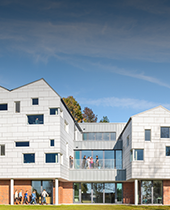7 Ways to Reduce Middle Schooler Stress and Improve Their Ability to Learn
By Kate Ziminsky (Middle School seminar instructor)
Life can feel overwhelming to the middle schooler who is navigating longer periods of focused attention on academics, working to balance extracurricular activities with homework, and beginning to chart a course toward adulthood and self-reliance—all while a large volume of highly stimulating, provocative information streams in at high speeds, through myriad devices, at every moment of the day. To empathize with the challenges that your child faces at this stage in their development, it is important for you to learn more about the middle-school brain.
Wired to seek out novel experiences that often involve risk, activity in the adolescent brain is triggered by components of a highly sensitive emotion center called the limbic system. The brain is working overtime with both an overstimulated emotional center and an underdeveloped decision-making center that resides in the prefrontal cortex. Big emotions coupled with a reduced ability to make appropriate decisions—every middle-school parent knows the outcome. While middle schoolers cannot control their biology, there are tools that parents can use to help their children thrive during the wild ride of adolescence.
Dr. Dan Siegel, a clinical professor of psychiatry at the UCLA School of Medicine and executive director of the Mindsight Institute, created the “Seven Essential Mental Activities” model to guide parents who want to structure their children’s lives to maintain a healthy middle-school brain. In order of importance:
1. Sleep
Sleeping 9–12 hours provides the adolescent brain with the rest it needs to consolidate learning and recover from the experiences of the day. (Turn screens off two hours before bed! The blue light emitted from screens mimics sunlight and blocks the release of melatonin and adenosine—chemicals that our brains release to prepare our bodies for sleep.)
2. Focus
Closely focusing on tasks in a goal-oriented way helps make deep connections in the brain.
3. Connecting
We need to connect with other people to learn—in person, ideally. These human-to-human interactions activate the brain’s rich social circuitry, which aids in learning.
4. Downtime
By relaxing, being non-focused, and letting our minds simply wander without any specific goal, we help our brains recharge.
5. Play
Being spontaneous and creative—and playfully enjoying novel experiences—help to make new connections in the brain.
6. Physical
Aerobic exercise strengthens the brain by boosting the function of neurons and improves blood flow to brain cells.
7. Time in (reflection)
When we quietly reflect—focusing on sensations, images, feelings, and thoughts—we help the brain to both better integrate and process inputs.
When middle schoolers feel that their parents and teachers understand them and “have their backs,” they are more responsive and accepting of the guidelines and structures that are in place to enrich their lives (as opposed to feeling that they are being restricted by rules). When they are offered the “why,” they are more apt to respond positively and embrace the “how/what” of the process.
Waynflete middle schoolers are offered many opportunities to learn about their amazing brains, to practice self-care, and to practice making appropriate decisions in a safe and supportive environment. During a recent assembly, for example, students learned how singing and dancing as a community has been scientifically proven to repair cells and enhance productivity. Weekly seminar classes remind students about what their brains need to learn. These classes encourage them to practice positive habits to create new neural pathways that increase the size of their mental toolbox and enhance their life experiences for years to come.



